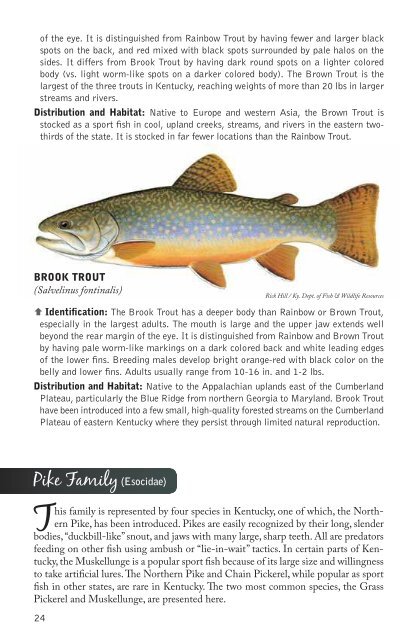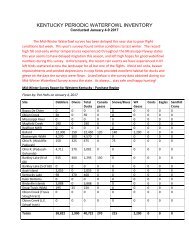Kentucky Fishes
kyfishid[1]
kyfishid[1]
- No tags were found...
Create successful ePaper yourself
Turn your PDF publications into a flip-book with our unique Google optimized e-Paper software.
of the eye. It is distinguished from Rainbow Trout by having fewer and larger black<br />
spots on the back, and red mixed with black spots surrounded by pale halos on the<br />
sides. It differs from Brook Trout by having dark round spots on a lighter colored<br />
body (vs. light worm-like spots on a darker colored body). The Brown Trout is the<br />
largest of the three trouts in <strong>Kentucky</strong>, reaching weights of more than 20 lbs in larger<br />
streams and rivers.<br />
Distribution and Habitat: Native to Europe and western Asia, the Brown Trout is<br />
stocked as a sport fish in cool, upland creeks, streams, and rivers in the eastern twothirds<br />
of the state. It is stocked in far fewer locations than the Rainbow Trout.<br />
GRASS PICKEREL<br />
(Esox americanus)<br />
Matthew Thomas / Ky. Dept. of Fish & Wildlife Resources<br />
Ç Identification: An elongate fish with a duck-like snout and large mouth with sharp<br />
canine teeth. The dorsal fin is far back on the body. Color is dark olive on the back<br />
with dark green to brown wavy bars along the side, and a black vertical stripe below<br />
the eye. Adults grow to 15 in. (about 1 lb.)<br />
Distribution and Habitat: Common in the western half of the state, but also occasionally<br />
encountered in the eastern half. Grass Pickerel inhabit primarily sluggish<br />
streams and densely vegetated sloughs, ditches, ponds, and lakes.<br />
MUSKELLUNGE (Esox masquinongy)<br />
BROOK TROUT<br />
(Salvelinus fontinalis)<br />
Rick Hill / Ky. Dept. of Fish & Wildlife Resources<br />
Ç Identification: The Brook Trout has a deeper body than Rainbow or Brown Trout,<br />
especially in the largest adults. The mouth is large and the upper jaw extends well<br />
beyond the rear margin of the eye. It is distinguished from Rainbow and Brown Trout<br />
by having pale worm-like markings on a dark colored back and white leading edges<br />
of the lower fins. Breeding males develop bright orange-red with black color on the<br />
belly and lower fins. Adults usually range from 10-16 in. and 1-2 lbs.<br />
Distribution and Habitat: Native to the Appalachian uplands east of the Cumberland<br />
Plateau, particularly the Blue Ridge from northern Georgia to Maryland. Brook Trout<br />
have been introduced into a few small, high-quality forested streams on the Cumberland<br />
Plateau of eastern <strong>Kentucky</strong> where they persist through limited natural reproduction.<br />
adult<br />
immature<br />
John MacGregor / Ky. Dept. of Fish & Wildlife Resources<br />
Pike Family (Esocidae)<br />
This family is represented by four species in <strong>Kentucky</strong>, one of which, the Northern<br />
Pike, has been introduced. Pikes are easily recognized by their long, slender<br />
bodies, “duckbill-like” snout, and jaws with many large, sharp teeth. All are predators<br />
feeding on other fish using ambush or “lie-in-wait” tactics. In certain parts of <strong>Kentucky</strong>,<br />
the Muskellunge is a popular sport fish because of its large size and willingness<br />
to take artificial lures. The Northern Pike and Chain Pickerel, while popular as sport<br />
fish in other states, are rare in <strong>Kentucky</strong>. The two most common species, the Grass<br />
Pickerel and Muskellunge, are presented here.<br />
David Eisenhour/ Morehead State University<br />
Ç Identification: The Muskellunge has a general body shape and appearance that<br />
is similar to the Grass Pickerel, but grows to a much larger size. It is further distinguished<br />
from the Grass Pickerel by lacking a vertical black stripe below the eye.<br />
Color is dark green or brown on the back and silvery on the sides with dark broken<br />
vertical bars (faded in adults). Fins are olive to reddish-brown, often with large dark<br />
spots. Adults from northern populations are reported to reach 6 ft (72 in.) and 70<br />
lbs. In <strong>Kentucky</strong>, individuals exceeding 50 in. (40 lbs) are uncommon.<br />
Distribution and Habitat: Native to the Green, <strong>Kentucky</strong>, Licking, and Little Sandy<br />
river drainages, and Kinniconick and Tygarts creeks. The Muskellunge inhabits pools of<br />
medium to large rivers, often near fallen logs with accumulated debris. Fish are stocked<br />
annually in Green River, Cave Run, and Buckhorn lakes, where they are usually found in<br />
shoreline habitat associated with structure. Several stream populations are also maintained<br />
through supplemental stockings due to poor reproductive success in the wild.<br />
24 25



